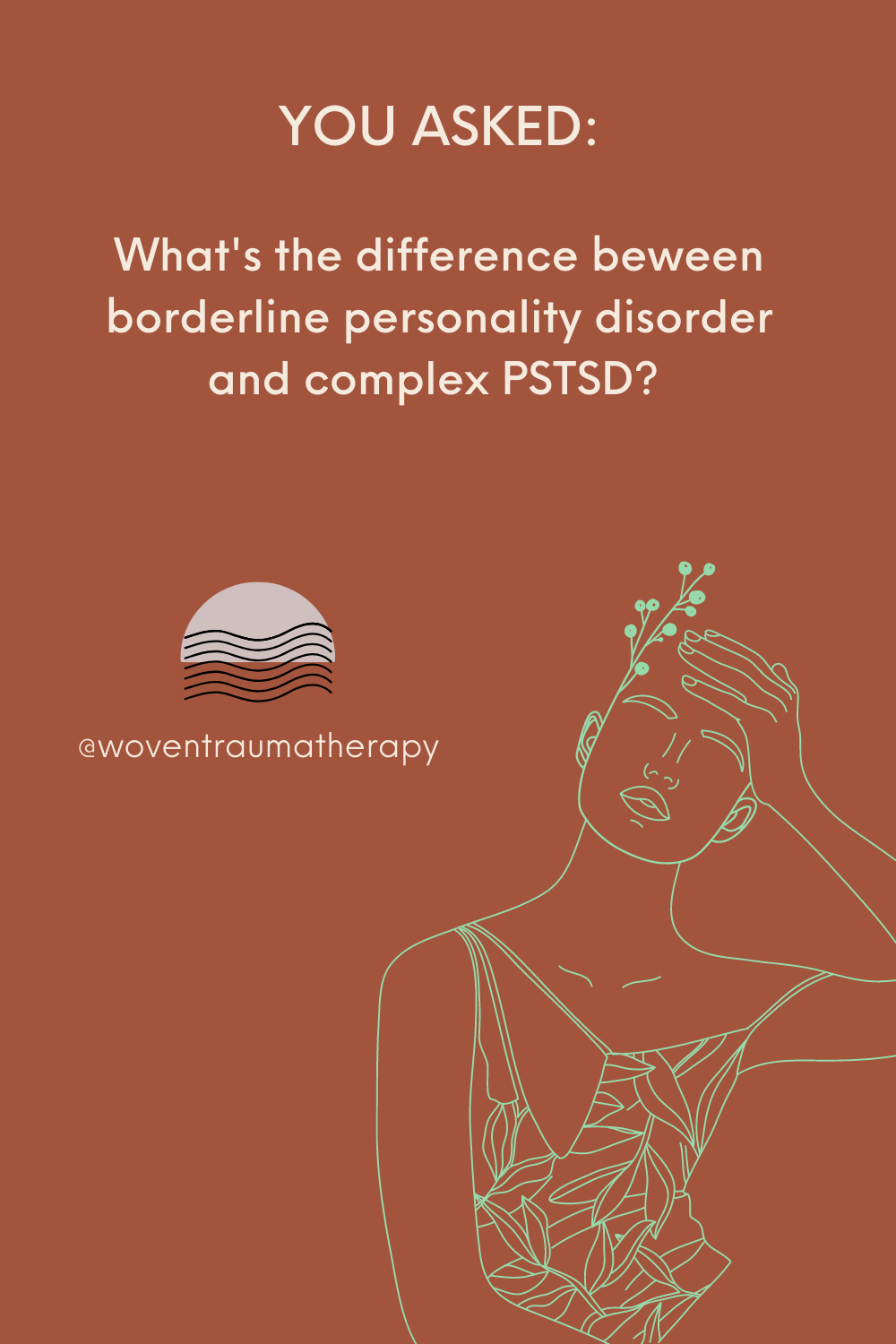Difference Between Borderline Personality Disorder and Complex PTSD
One common question we get from trauma survivors is: What is the difference between Borderline Personality Disorder (BPD) and Complex Post-traumatic Stress Disorder (CPTSD)? As with all diagnoses, the nuances are really important to acknowledge when it comes to understanding diagnoses, diagnostic criteria and the events leading up to the diagnosis. Remember: self-diagnosis can be a destructive path. Find a professional to discuss your concerns with before assuming you meet diagnostic criteria for any mental health disorder.
Let’s talk about each of the diagnoses and the criteria we use to diagnose them. A psychologists, we get this criteria from two main sources:
The Diagnostic and Statistical Manual of Mental Disorders (5th edition)
Clinical examples from patients and clinicians
Borderline Personality Disorder
Borderline personality disorder is a pervasively unstable self-image with potentially self-damaging behaviors. Those behaviors can be sex, spending, reckless behavior, binge eating, self-harm, etc. Patients with BPD usually feel pretty empty inside, have moments of explosive anger and can even be paranoid about other's intentions. There's usually a lot of internal turmoil and shame over behaviors or existence.
Here’s the general list of symptoms that we look for when diagnosing Borderline Personality Disorder:
Fear of abandonment in relationships.
Those with BPD typically have a huge fear of abandonment, rejection or relationships ending. This can be from real or perceived threats of abandonment in their relationships. In other words, sometimes abandonment might seem like a silly possibility to the people around them, but to the person with BPD, it’s going to feel like a full-time job managing this fear.
Unstable relationships.
For this, we typically look at all relationships, which include romantic, friendships, and with family members. If, in therapy, we notice a pattern of a person reporting a felt sense of closeness with others followed by a sudden or catastrophic end to that relationship weeks or months later, this can be a clue that a borderline process is a play.
Unclear or shifting self-image.
Clinicians usually hear patients with BPD report that they have a difficult time understanding themselves, their values, or their own self-image. This usually plays out by a person being exceptionally focused on the perception of others and remaining in relationships even if they are unstable. Remember that fear of abandonment? It keeps folks from feeling like they can focus on their own development.
Impulsive, self-destructive behaviors.
These can range from sex, spending, reckless behavior, binge-eating or self-harm. The impulsive part is the part to look out for. How fast was the decisions to engage in these behaviors reached? How impulsive was the behavior?
Self-harm behaviors.
These behaviors can be anything that harms the person, but also gives them some emotional relief. Trigger warning here: this can be cutting, burning, or other self-mutilating behavior.
Extreme emotional swings.
This is the symptom that might be most obviously identified in someones struggle with borderline personality disorder. These significant mood swings are significant are sometimes mislabeled “bipolar,” but this is an incorrect descriptor because these mood swings are typically rooted in some relational issue.
For instance, someone with BPD might struggle to stay calm when they feel there’s a perceived threat of a relationship ending. This would not be the same for someone with bipolar disorder, as those mood swings are generally related to chemical changes in the brain that can take up to several days to fully display.
Chronic feelings of emptiness.
There’s typically a sense of emptiness and then the added shame that goes along with “feeling needy”.
Explosive anger.
This can be a tricky one to discuss because there is typically a lot of shame for the person struggling with borderline personality disorder to admit that they’ve had explosive moments of anger. Partners, friends, and close relationships are usually better at reporting this to the clinician for diagnosis.
Paranoia.
Lastly, there’s the paranoia that can happen with BPD. It can typically flare up in moments when someone is feeling particularly disconnected from meaningful relationships.
Complex Post-traumatic Stress Disorder
Complex PTSD is a relatively new term (it's not even in our diagnostic manual yet) that describes the stress response that happens after chronic or childhood trauma. It can cause difficulty in relationships, highly dissociative habits, feelings of shame or guilt, and difficulty controlling emotions. This results from experiencing chronic or complex trauma, which can mean childhood abuse, trauma or loss, as well as other chronic traumas in adulthood.
There’s no diagnostic criteria that has been acknowledged in our diagnostic manuals, but here’s what clinicians understand CPTSD to be:
Deep fear of trusting others and hyper-vigilance.
This typically means that a person struggles to feel connected and comfortable in relationships with others. The patient often experiences a deep distrust of the motivations and desires of others. This can make medical appointments, teacher relationships, and work relationships very difficult. Hyper-vigilance means that the trauma survivor is constantly watching and evaluating others to make sure they are still safe to interact with.
Extreme loneliness.
There’s a deeply felt sense of loneliness for the survivor that stems from difficulty feeling close to others while also longing to feel close, safe, and rescued by others.
Extreme emotional swings.
The internal world of someone with CPTSD is complicated and full of difficult emotional states. This means that the outward expression of emotional states appear to change from moment to moment and can be difficult for others to track.
Emotional flashbacks.
Emotional flashbacks are when something in the environment triggers a person to return back into an old emotional space that they once occupied while experiencing the chronic trauma. It can last hours to days and it is very upsetting and uncomfortable for the traumatized person. These are different from cognitive flashbacks (one of the more recognizable symptoms of PTSD).
Change in worldview.
This is a shared symptom with classic PTSD. Oftentimes a trauma survivor has a change in their faith, worldview, or posture towards others due to the traumatic experience such as no longer believing in God or having difficulty believing that most people are generally good.
Helplessness.
Helplessness is a common and important feature of CPTSD. There’s a general sense of helplessness in most areas of one’s life: relationships, finances, work, parenting, etc. Because of this, the survivor tends to feel like there is very little option for them to thrive and so their purpose in life becomes to just survive.
Extreme shame.
In trauma, but especially childhood trauma, shame is typically a prominent element in parenting or traumatizing the child. This shame persists into adulthood and leaves the survivor feeling shameful about most of their feelings, needs, and desires in the world.
Childishness.
This describes a specific state that the survivor might retreat to when they are triggered leading them to speak, behave, or react like they did when children. This can look like tantrums, meltdowns, and having difficulty hearing feedback from others.
Dissociation.
This is the felt sense of no longer being cognitively or emotionally present in your body, surroundings, or current interactions. It can feel like an “out of body” or “out of mind” experience with symptoms like brain fog, difficulty tracking words from others, or depersonalization.
Chronic depression or suicidality.
For those struggling with CPTSD, the inner world can be quite uncomfortable leading to a completely natural, yet unfortunate, response of depression. When that depression becomes overwhelming, suicidal thoughts or gestures can happen. If this happens, it is really important to reach out to a professional for help.
Codependency/search for a rescuer.
This is a relational dynamic where the trauma survivor longs for someone to come into their lives to lessen the pain, dissipate the sadness, and to feel a sense of connection once again. This can lead to the search for a rescuer or someone to be “in charge” of their feelings.
Final Thoughts
After these descriptions, you might notice the similarities between the diagnoses of borderline personality disorder and complex post-traumatic stress disorder. They might not be distinguishable to you or a mental health professional without some exploration in therapy. If you have questions about your diagnosis, please speak with your therapist about your concerns and the symptoms that you notice. Print out this list if you need them so can discuss each thoroughly.
Interested in learning more about complex trauma? Here are a few blogs discussing complex trauma and CPTSD.
If you need a mental health professional and you live in the state of California, speak with one of our therapists in a free 15-minute consultation. We provide online therapy and have therapists who are trained in emdr therapy. We also offer many different types of trauma therapy groups. All of our therapists specialize in trauma informed care, and informed trauma therapy.
All therapists at Woven Together Trauma Therapy are trauma-informed and specialize in treating all forms of trauma. We also offer EMDR, Ketamine Assisted Psychotherapy, and Brainspotting which has shown to be extremely effective in treating and healing trauma. Want to read more about our unique therapy options?
These blogs talk more about the basics of EMDR:
You can read more about Ketamine Assisted Psychotherapy here:
If you would like to learn more about Brainspotting, check out our blog: What is Brainspotting?





